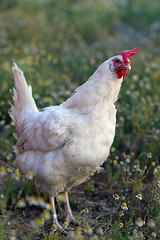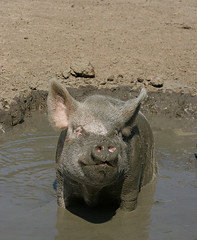Perhaps "opposition" isn't the fairest of terms, but this author does posit much of the opposition's rhetoric. It's hard not to imagine the by-line reading "Foster Farms Fred".
Note: Please do your best to ignore the grammatical and spelling errors.
So let's see what the opposition is saying about "Animal rights loony tunes".
It is true that HSUS does not operate a traditional dog and cat shelter. That does not preclude them legally using humane society in their non-profit's name. Both concerns (that HSUS doesn't run a dog and cat shelter & that it receives millions in donations) beg the question - what bearing does this have on the discussion?Two of the worst offenders are Farm Sanctuary and the Humane Society of the United States (HSUS), which it should be pointed out, is a multi million dollar organization that runs no animal shelters and is not affiliated with your local animal shelter.
As an aside, HSUS does operate five animal care facilities - Black Beauty Ranch, Duchess Sanctuary and three wildlife care centers. They may not be traditional dog and cat shelters but, by definition, they provide shelter to animals.
HSUS takes advantage of the confusion of many good hearted animal lovers who have been mislead by the pictures of dogs and cats on their fun raising literature. The Humane Society of the United States has 113 million in assents according to a watchdog web site called ActivistCash.com.I'm confused (which is apparently a sign of HSUS taking advantage of me). How does using dogs and cats, animals the organization helps, a disingenuous form of fund-raising? Setting aside personal feelings for an organization, there is no doubt that the non profit in question has used funds to rescue, for example, dogs from puppy mills or cats from hoarding situations.
ActivistCash.com, in case you were wondering, is a website run by the Center for Consumer Freedom, an organization funded and created to support the tobacco, alcohol, restaurant and agriculture industries. They may have a vested interest in presenting a damaging view of the competition, in this case the animal rights/welfare movement. ActivistCash.com does not offer an unbiased presentation of fund management; instead it inserts editorialized commentary on groups like Mothers Against Drunk Driving, Farm Sanctuary, Natural Resources Defense Council and the American Corn Growers Association.
There is nothing wrong with wanting to know where and how your donations are used. Perhaps a more useful resource would be a non-biased organization that looked at how your donations are used. For example, Charity Navigator takes into consideration financial efficiency and the organization's capacity to grow. If you are interested in how organizations optimize their incoming donations, this is a far more effective tool than ActivistCash.com.
American farmers, already struggling with tough times are operating on a very slim profit margin in most cases.Defining should occur. What is a "struggling American farmer"? Is it Pilgrim's Pride who's annual sales top $8 billion and net income is nearly a billion? Is it Perdue, one of the largest chicken processors, with $4.3 billion in sales and a 28.5% increase in profit? Or are we limiting the "struggling American farmer" term to those farmers that help bolster the author's argument? These are fair questions that could help to shape the debate a bit more squarely.
The veal farming laws passed in New Jersey, land of no veal farmers, mandates that calves be fed iron and fiber. Sounds very humane don’t it? Again, the law is bad for the animals and the farmers alike. Iron promotes diarrhea, and fiber tears up a calf’s digestive tract.Let's ignore the nutritional requirements of calves. Crating male dairy calves is still legal in New Jersey, as far as this author knows. Bills were introduced in 2002-2003 and 2004-2005. They failed. Now had they passed, this is what it would have said about iron and fiber: " b. The calf must be fed a daily diet containing sufficient iron to prevent anemia and maintain it in good health and vigor and, if the calf is more than 14 days old, it must be provided each day with food containing sufficient digestible fiber to prevent impairment of the development of its rumen." There is no reading between the lines here - the calf needs enough iron to prevent anemia and maintain good health (diarrhea = not good health). Getting into the details of rumen development in calves is interesting but a bit labor intensive. The bill would have required some non-milk food to be introduced into a calf's diet after the age of 14 days which is absolutely normal (i.e. a calf would start nibbling on grasses as young as 1-2 weeks of age, even though milk remains his primary source of nutrition). The bill never suggested calves be fed inordinate amounts of grain or hay, it stated that the calf be provided sufficient digestible fiber to promote normal rumen development.
Farm Sanctuary now has California on its list of things to do, and a legislative agenda in every state in the union. A story in the Sacramento Bee, by Aurelio Rojas, shows the same old list of destructive demands to change live stock agriculture plus demands for changes in the way chickens and eggs are produced.California passed Proposition 2 last November, almost a year ago. It requires calves raised for veal, pregnant sows and hens in the egg-laying industry be given enough room to turn around, lie down, stand up, stretch their limbs/wings without touching the sides of their enclosure. Again, it has already passed and goes into effect in 2015. Ideally, a journalist should gather all their resources and, to the best of their ability, present factual, updated information. A simple Google search would have yielded the desired results, in this case.
How effective is Farm Sanctuary’s Hog farming law? From Britain there comes disturbing indications.This (ban on the tether-crate system) was blamed for the parlous state the UK’s pig producing industry is now in, by a committee of MP’s called The Commons Environment Food and Rural Affairs Select Committee.If you so desire, you can read the actual 160+page report here.You can also read here how pig farmers are faring poorly because of the incredibly high increase in feed prices. There are many reasons why the British pig industry is doing poorly. Lack of government support meant pig producers had to cover the cost of transitioning away from a crate system. Many of those who submitted evidence considered feed prices as the number one reason for the poor pig flesh market - 50-60% of the cost for raising a pig is from the feed. Further, the farmers rely heavily on imported soya for their feed. Supermarket and grocer retailers were not compensating for the increase in feed, meaning a farmer may need $1.6/kg to raise a pig but is only going to get $1.44/kg from the retailer. Welfare requirements other than the crate issue also play a role, including the regulations regarding how close slaughterhouses have to be to farms (they have to be much closer than their continental counterparts) - it means either moving farms closer to slaughterhouses, increasing number of slaughterhouses or going out of business. Another welfare issue is that Britain does not castrate its male pigs - great for the pigs but also means they are slaughtered at a smaller weight to avoid "boar taint", an unpleasant smell and taste a small percentage of consumers experience when cooking the flesh. Several disease outbreaks also affected the industry. The committee does not conclude that bringing back gestation crates will be the sole determining behavior in rectifying the problem.
I mean, I'm not running home crying when I read that British pig farmers aren't doing well. But it isn't solely because of the ban on tether/crates, as this author states. It's a whole host of reasons that, combined, meant a poor market for pig farmers.
These aren't the only inconsistencies and unsound arguments made by the author. You can read the article and see for yourself, there's a whole host of inaccuracies.
Now, this person does not run a multi-billion dollar industry. He doesn't have a lot of lobbying power or a government subsidy to keep his stuff published. His methods of diversion and logical fallacies certainly falls in line with how agribusiness tends to promote themselves. So maybe the only sad thing is that there are people who believe this person's arguments, who read all the errors and blatant misrepresentations and thinks "this person is on to something." I mean, that's scary.
But for those of us who argue for animals, it's easy. We don't have to lie or twist the truth. We don't have to create ads with pastoral settings to mask the dry-lots, crates and slaughterhouses. There is nothing mysterious or difficult.
All we have to do is speak the truth with integrity. It's that simple.








1 comments:
It's so sad when people try to deflect from the main problem and finger point to good folks trying to make a change. Every good cause will have its critics. I also think publicity is publicity. An average intelligent Joe or Jill may take the time to research your great organization before forming an opinion. Let's hope Americans are still independent thinkers and not lazy enough to have others think for them.
Post a Comment